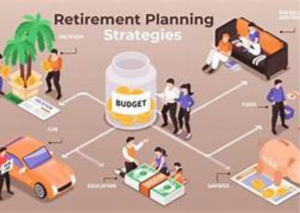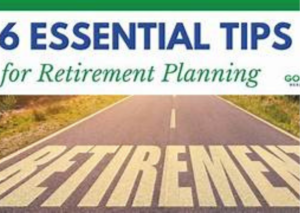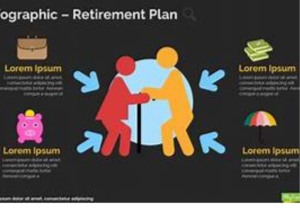What Is Retirement Arranging?
Identifying your long-term financial objectives and risk tolerance is the first step in developing a retirement strategy. The next step is to begin taking steps toward achieving those objectives. The process can begin at any point in your working life, but the earlier it starts, the better.
Identifying your sources of income, adding up your expenses, implementing a savings strategy, and managing your assets are all steps in creating a retirement plan. By assessing your future income, you can decide whether your retirement pay objective is reasonable.
A retirement plan is not a fixed piece of paper. You’ll have to refresh it periodically and survey it to monitor your progress.
What Is a Retirement Plan?
A retirement plan is a guide to an agreeable life after work. It involves saving up enough money to afford the lifestyle you want in the future. While your retirement strategy may evolve, the earlier you begin, the better.
0 seconds of 2 minutes, 30-second volume 75% Essential
Tips for Saving for Retirement
How Retirement Planning Works:
A retirement plan is to prepare yourself for a comfortable life after you’ve finished working to pay the bills or at least finished working a full-time job. However, it’s not about cash.
The non-monetary perspectives incorporate way-of-life decisions, such as how to invest your energy in retirement and where you’ll reside. A holistic approach to retirement planning considers all of these aspects.
The objectives for your retirement plan will change in the center over the long haul:
- A commitment to retirement reserve funds might be unassuming in an individual’s functioning life. The reward is investment growth for more than 40 years.
- During the center of your vocation, when your pay might be at its pinnacle, you could set explicit pay or resource targets and move toward accomplishing them.
- When you reach retirement age, what financial planners call the distribution phase begins. You have stopped contributing to your retirement accounts. Instead, you reap the benefits of decades’ worth of investments.
Some retirement plans change depending on where you are. The US and Canada each have frameworks for working environment-supported plans.
The amount Do You Have to Resign?
Your enchanted number, which is the sum you want to resign easily, is exceptionally customized. Yet, dependable guidelines can give you a rough idea of the amount to save.
- Individuals used to say you want around $1 million to resign easily.
- The 80% rule indicates that you must have 80% of your current income to live without problems after retiring, which other professionals use. So, if you made $100,000 yearly, you would require reserve funds that produce $80,000 yearly for around 20 years or $1.6 million.
- Others argue that most people are not saving nearly enough to meet those standards, and they should adjust their lifestyles accordingly.
Estimating Costs Your “magic number” is determined mainly by your post-retirement costs.
Creating a retirement budget with estimated costs for housing, health insurance, food, clothing, and transportation is a good idea.
Furthermore, since you’ll have all the sparer energy, you may need to consider the expense of amusement, side interests, and travel.
Although it may be challenging to arrive at precise figures, a reasonable estimate will be helpful.
Moves toward Retirement Arranging
Despite where you are throughout everyday life, a few critical advances apply to nearly everybody during their retirement arranging. Some of the most common ones are as follows:
- Concoct an arrangement. This incorporates choosing when to begin saving and when to resign, as well as how much you want to put aside for your objective.
- Conclude the amount you’ll save every month. Utilizing programmed allowances removes the mystery, keeps you on target, and removes the impulse to stop or neglect to store cash alone.
- Pick the correct records for you. Put resources into a 401(k) or comparative record, assuming your boss offers that choice. Assuming the organization provides a business match, and you don’t join, you must offer cash. Whether there’s a business match, you get a decent arrangement charge-wise.
- Adjust and periodically check on your investments. This is especially crucial after a significant event, such as a wedding or a baby.
Retirement Plans
Charge-advantaged retirement reserve fund plans have become the cornerstone of Americans’ long-haul reserve funds. Depending on your life, one or more plans should be available. Each has its standards and guidelines.
Most large organizations offer their employees 401(k) plans, and philanthropic businesses have comparable 403(b) plans.
A direct advantage of these certified retirement plans is that your manager can match your contributions to a specific sum. For instance, assuming you contribute 3% of your yearly pay to your arrangement account, your manager might match that sum, keeping the aggregate in your retirement account alongside your commitment.
You can contribute more money than your employer will match. A few specialists suggest contributing as much as 10%.
401(k) Cutoff points
The greatest is overhauled yearly by the IRS. In 2024, members can contribute up to $23,000 to a 401(k) or 403(b), a portion of which might be added to with a business match. Individuals over 50 can contribute an extra $7,500 yearly to compensate for the lost time commitment in 2024.
These records can procure a much higher pace of return than an investment account (albeit the ventures are not liberated from risk). The assets in the record, on the off chance that they are customary records as opposed to Roth accounts, are only burdened once you pull them out. You will get a quick personal tax cut since your commitments are removed from your gross pay.
People on the cusp of a higher expense section should seriously consider contributing to the point of reducing their duty responsibility.
Customary Individual Retirement Records (IRAs)
The customary individual retirement account (IRA) is like a 401(k) plan; however, it can be obtained at practically any bank or financier. It is primarily for self-employed individuals and others who do not have access to a 401(k), but anyone who makes an income can invest in an IRA.
The cash you save in an IRA is deducted from your pay for the year, reducing your available income and, thus, your assessment obligation.
The tax cut to this sort of record is forthright. So when it comes time to take disseminations from the record, you depend on your standard duty rate around then. However, keep in mind that the money grows tax deferred. No capital increases or profit burdens are evaluated on the equilibrium of your record until you start making withdrawals.
IRA Cutoff points
The IRS draws certain lines on the amount you can add to a conventional IRA annually. The cutoff for 2024 is $7,000. For $8,000 in 2024, people over 50 can invest an additional $1,000.
Disseminations should be taken at age 72 and can be taken as soon as 59½. You will owe charges on the withdrawal at your ordinary annual expense rate for that year.
Roth Individual Retirement Record (IRA)
A Roth IRA is supported with post-charge dollars. This is an excellent alternative to the IRA because it offers a lot of gain in the long run for a little more pain in the beginning.
The Roth IRA takes out the prompt duty derivation of the customary IRA. The cash you pay into it is burdened in that year.
In any case, you ought to owe no charges when you begin pulling out cash, either on the sum you put in or the venture acquires it gathered.
Beginning a Roth IRA early can take care of big time over the long haul, regardless of whether you have a truckload of cash to contribute from the start. Keep in mind the more drawn out the money sits in a retirement account, the m




